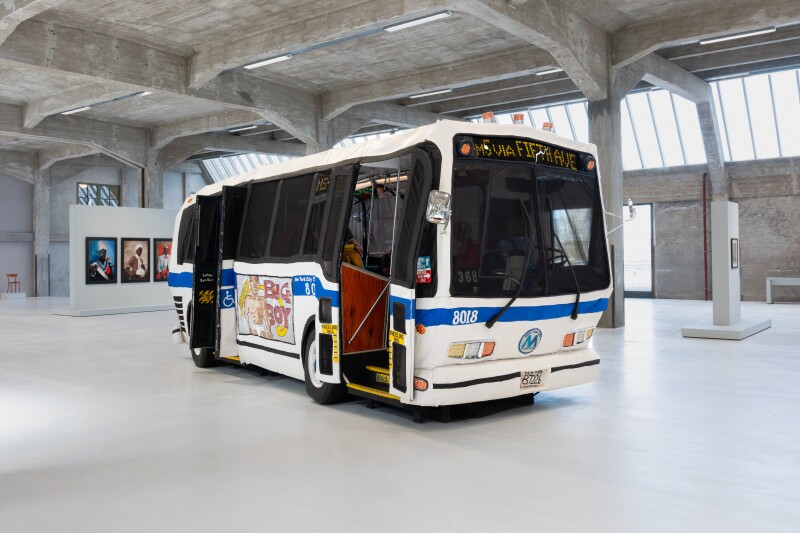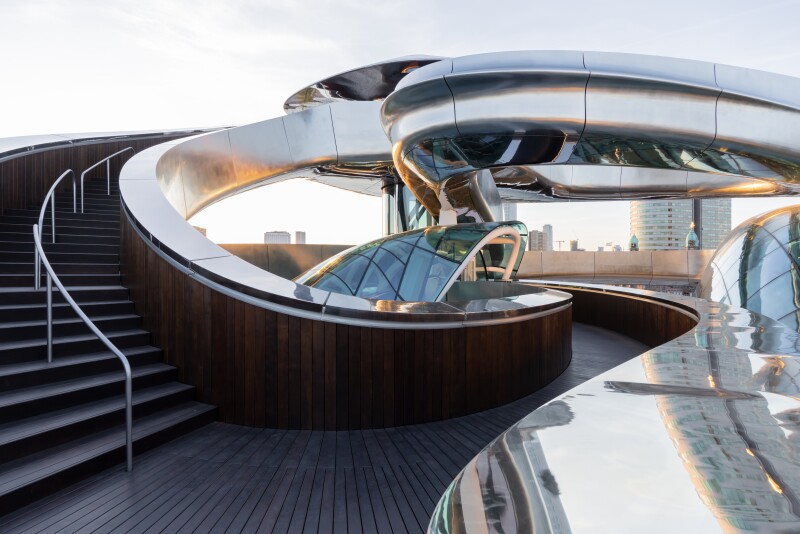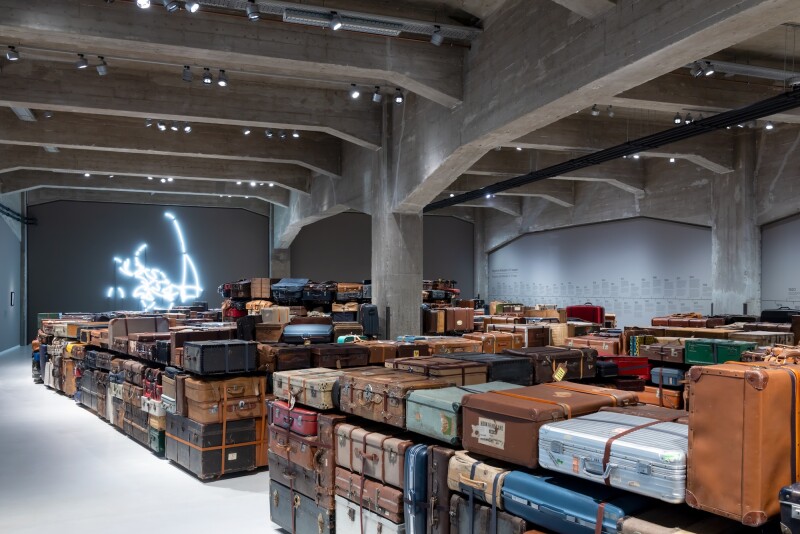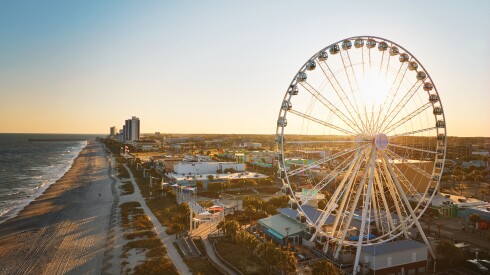Rotterdam’s newest cultural landmark, the Fenix museum, opened in May with the most striking addition to the Dutch port city’s skyline in years: a double-helix, stainless steel staircase and viewing platform that rises like a swirling tornado from the roof. But what’s inside is even more remarkable. It’s an art museum dedicated to the theme of migration, with more than 170 exhibits, artifacts, and works from 100 artists across various mediums, all reflecting various aspects of human journeys.
“We tell big histories, but also very small personal histories,” museum director Anne Kremers tells Afar. Early in the years-long curation process, she says, her team decided to broaden their perspective, shifting away from an initial strategy focused on works “literally about migration.”
“Then we shaped these themes about identity, about borders, about hope, and that really gave us the opportunity to collect work that reflects on things like homesickness, finding happiness, going on an adventure, how your identity is being shaped by other people throughout history,” Kremers explains. “That gave us a little bit of freedom with these artists to [interpret] the theme of migration in a different way.”
Here’s what to know about the newest addition to the cultural scene in Rotterdam, just a quick, 35-minute train ride from Amsterdam.
Rotterdam’s maritime history

Fenix is built within 1920s-era warehouses formerly used by the Holland America Line.
Courtesy of Rotterdam City Archives
Fenix is located in what was once part of the world’s largest storage and transshipment warehouse, on the south bank of the Maas River in Katendrecht, Rotterdam’s historic port district. The nearly 1,200-foot-long concrete building was constructed from 1921 to 1923 for the Holland America Line, whose headquarters were nearby. Along with cargo, millions of emigrants boarded ships bound for the U.S. and Canada from nearby docks, including the likes of Albert Einstein and abstract expressionist painter Willem de Kooning (who has a 1969 painting in the galleries).
The massive human migrations left their mark on Rotterdam, too. Many immigrants eventually settled in the city, whose 664,000 inhabitants represent more than 170 nationalities. Fittingly enough, Katendrecht marked the first Chinatown on mainland Europe, and the area also served as a gritty sailors’ quarters with its own red light district.
The museum’s wide-ranging art collection

Red Grooms’ The Bus is a nearly life-sized sculpture of a bus filled with cartoon-like characters.
Photo by Titia Hahne
Among the collection highlights is a newly discovered portrait of the Rotterdam-born philosopher Desiderius Erasmus by Hans Holbein the Younger; the well-traveled Renaissance thinker called himself “a citizen of the world, at home everywhere, or rather, a stranger to all.” Galleries also include a section of the Berlin Wall and photographs by the likes of Dorothea Lang and Steve McCurry, but its most eye-catching installations are also its most interactive.
Indian artist Shilpa Gupta’s untitled is a tall metal gate topped with ornamental spikes, similar to those surrounding homes in some wealthy neighborhoods. Every half hour, it swings and crashes into the wall, leaving chunks of falling plaster and startled museum guests in its wake. As the placard explains, the work “exposes what a border means to those who are excluded: a merciless blow.”
“It’s interesting to see how people interact with the work,” Kremers says. “Some people start to laugh, and others jump.”
The Bus, meanwhile, a 1995 work by Nashville-born multimedia artist Red Grooms, offers a more playful note. Museum patrons, not unlike real-life passengers, queue up to board the fabric-and-wood bus; once inside, they can walk through seats filled with cartoonish riders reading, sleeping, and chatting—an artistic rendition of the melting-pot-on-wheels constantly chugging through the Big Apple.
Wildly inventive architecture and a stunning view

The rooftop Tornado structure offers 360-degree views of Rotterdam.
Photo by Iwan Baan
Envisioned by MAD Architects founder Ma Yansong, the showstopping rooftop Tornado makes for a striking photograph, but it has a deeper meaning as well: It symbolizes “movement and transition, echoing the journeys taken by generations of migrants,” according to MAD’s project description.
The ethereal structure comprises 297 stainless steel panels that had to be carefully fitted together and integrated with the curving staircases, whose wood elements evoke a ship’s deck. “Ma really wanted it to float in space, and [that process] was very hard,” Kremers says. “Two thousand people worked on this construction to make it float.”
When the installation process began, passers-by began to speculate that the work-in-progress was a waterpark slide or other amusement park feature, Kremers notes. But she adds that the end result has been well worth the tremendous effort (and any initial confusion from locals): “It really is a prestige structure, and we see it as the first artwork in our collection.”
A labyrinth of luggage from all over the world

Fenix curators collected more than 2,000 pieces of luggage for its Suitcase Labyrinth installation.
Photo by Iwan Baan
Visitors shouldn’t miss a ground-floor exhibit called the Suitcase Labyrinth: a maze made of more than 2,000 steamer trunks, retro hard-shell wheeled cases, and the occasional duffel bag. Some are covered in stickers, others nearly pristine, many showing the wear and tear from countless journeys.
The museum team traveled to the U.S., Canada, and throughout the Netherlands to pick up donated pieces. But early on, they leaned into the bigger picture beyond the baggage: “In the beginning, we saw them more as building blocks, but very soon, we realized that it’s not just the suitcase, it’s the story of the owner that is super interesting,” Kremers says. “So from then, we interviewed every suitcase owner.”
Museumgoers can listen to audio recordings of owners sharing personal insights about the fascinating backstory of their pieces. One account of note is that of Willemine, a Dutch woman who returned to the Netherlands from China on the Trans-Siberian Railway with her four children in 1911, following a divorce from her husband. Her suitcase, which dates to 1898, is the oldest in the collection.
A café inspired by immigrant flavors

Chef Maksut Aşkar brings the Turkish flavors of his upbringing to O Anatolian Café & Bakery; the menu includes dishes like hummus with fresh herb salad and a full roster of fresh-baked breads and pastries.
Photos by Cijrille Kurvers
An espresso bar on the museum’s second level is ideal for a quick coffee break while enjoying views of the port. But the restaurant on the ground floor, O Anatolian Café & Bakery, is worthy of a relaxed post-exhibit meal. Its name is a Turkish word that means “he, she, it, that, and those,” as the menu explains, and it fittingly reflects the museum’s themes: It’s the creation of chef Maksut Aşkar—of Michelin-starred Istanbul restaurant Neolokal—whose family was originally from Syria but became Turkish when international borders moved around them.
Askar’s menu reflects the cuisine of Anatolia: Think mücver (zucchini fritters with yogurt dip), labneh sandwiches, and a traditional bean stew called kuru fasulye. Turkish wines are also on the menu, while a bakery turns out traditional sweet and savory treats like sourdough bread and Turkish sponge cake.
Where to stay in Rotterdam
Today, Katendrecht is one of Rotterdam’s hippest neighborhoods, but the area remains true to its maritime roots. After a visit to the Fenix, visitors can stay overnight at Hotel New York, housed in Holland America’s former headquarters, or bunk up on S.S. Rotterdam, one of the company’s former cruise ships that now serves as a hotel.











